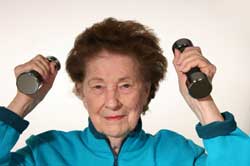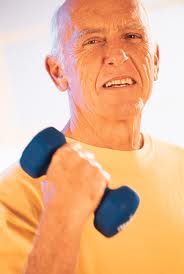21
2013
Fast training increases function in seniors
 Strength training is routinely emphasized by fitness professionals and for good reason. Strength training is good for your bones, good for your health and working out can be fun. In seniors, muscle strength is a main factor in the performance of everyday tasks. Whether it be carrying groceries or picking up the grand kids, strength training and being strong is important to everyone, but especially for senior’s quality of life.
Strength training is routinely emphasized by fitness professionals and for good reason. Strength training is good for your bones, good for your health and working out can be fun. In seniors, muscle strength is a main factor in the performance of everyday tasks. Whether it be carrying groceries or picking up the grand kids, strength training and being strong is important to everyone, but especially for senior’s quality of life.
Usually when working with seniors, strength training is executed with low to moderated weight at a slow to moderate tempo. This helps improve strength, but not power. Power training is defined as the speed at which you can do a particular task. In contrast, strength is the amount of force you can generate, and power is how fast you can generate that force. A heavy deadlift is an example of max strength — a heavy weight moving slowly. Throwing a baseball is more of a power exercise or jumping over a puddle — moving something relative light very fast. Both are important.
After the age of 50, muscle mass is lost at a rate of 1 – 2 percent per year. This decline in muscle mass (called sarcopenia) is partly due to reduced activity and decreases in anabolic hormones. With the loss of muscle mass, there is also a loss of strength and power. So it is important to train for both strength and power to keep both as we age.
But why train for power if seniors don’t often throw baseballs? Because seniors still need to resist falling and move their feet faster to avoid traffic. Also, according to a recent study, “Is power training or conventional resistance training better for function in elderly persons?” published in the Journal of Age and Ageing, “power training is feasible for elderly persons and has a small advantage over strength training for functional outcomes.”
 Some examples of power exercises include throwing medicine balls, box jumps, Olympic weightlifting and plyometrics. While tossing a small medicine ball may be OK for seniors, jumping and explosive push-ups are probably not the best options.
Some examples of power exercises include throwing medicine balls, box jumps, Olympic weightlifting and plyometrics. While tossing a small medicine ball may be OK for seniors, jumping and explosive push-ups are probably not the best options.
A simple and easy way for seniors to train for power is to lift a weight as fast possible and keep everything else the same. Even if the weight does not move fast, just trying to move the weight quickly will increase power. The majority of the studies that tested for power used machines, two to three sets for major muscle groups for two to three days per week.
There are safety considerations anytime anyone is training, particularly when dealing with seniors and high-speed training. Frail or deconditioned people who are starting with lower loads should start at 50 percent effort. Consult your doctor prior to starting any exercise program, and seek the advice of a fitness professional.
 An article by
An article by 